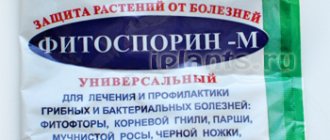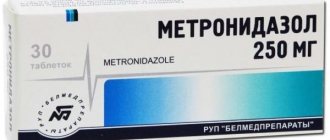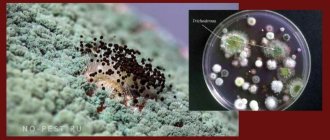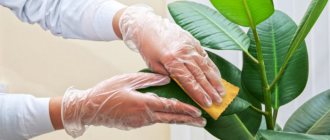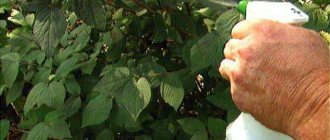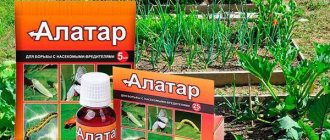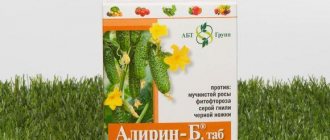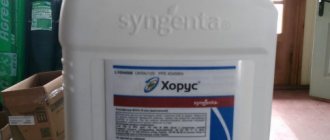In my greenhouse, I haven’t seen a tomato affected by late blight for many years.
All the fruits ripen on the vine, and I pick out the last bushes in mid-October. And all thanks to a miraculous biological product that I accidentally discovered at the dawn of my passion for gardening.
Fitosporin-M in paste is my faithful assistant in the fight against a wide range of diseases of garden and vegetable crops. There are sometimes reviews about this product on the Internet, saying that it doesn’t work, so you shouldn’t throw money away.
But since it has a biological basis, it is super important to strictly follow the instructions for use of Fitosporin-M paste. I note that the packaging provides only basic recommendations for its breeding . All the subtleties are taken out of the equation, and I will talk about them in the article.
Description of the drug, its characteristics and composition
Fitosporin is a completely natural preparation, one of the most famous biofungicides used in agriculture. The main effect of the drug is observed due to the activity of soil bacteria Bacillus subtilis - strain 26D (bacillus subtilis) contained in Fitosporin (in the liquid state it has a maximum concentration of bacteria - up to 2 billion in each gram).
Bacillus subtilis
A DIFFERENT FEATURE of Bacillus subtilis is that they can easily tolerate critical temperature changes (their range of vital functions is called: -50оС – +40оС), in which case they wait for better times in the form of spores.
The modern drug Fitosporin contains not only an environment favorable for bacteria and, in fact, the biomaterial itself, but also various additives. Most often, manufacturers use gumi - a combination of brown coal, nitrogen, phosphorus and potassium. By the way, gumi has a beneficial effect on the active development of roots and is a natural, but effective and safe growth stimulator for all plants. However, gardeners do not recommend using Fitosporin with this additive for fruit-bearing crops, as they will begin to grow into the roots, which worsens the future harvest.
In addition to gumi, you can find an additive in the form of ordinary chalk. It is more often used to form granules or give solid forms of release other specified sizes.
Presence of the “Gumi” additive in the preparation
Description of Fitosporin-M paste
This modern biological product is used for the treatment and prevention of various fungal and bacterial infections. The main active agent is the bacteria Bacillus subtilis.
When it gets into moist soil and plant tissue, Bacillus subtilis multiplies intensively and quickly displaces harmful fungi and other pathogenic microflora. The relationship of mutual assistance that arises between soil inhabitants and plants is beneficial to both parties.
The drug is available in the form of powder, liquid and paste.
Paste is a mass of black color, viscous texture, pressed into a rectangular flat cake. A gram contains at least 100 million live bacteria and Gumi fertility elixir.
The chemical composition of humic compounds includes brown coal, nitrogen, phosphorus, potassium, and traces of trace elements.
Unlike powder, Fitosporin in paste not only treats plants, but also feeds them for good root development.
It is sold in plastic bags and comes in four types:
- Universal - 200 grams;
- Instant tomatoes - 100 grams;
- Super-Universal Instant - 100 grams;
- Instant Potatoes - 100 grams.
Preparations for specific crops are enriched with special strains of bacteria that are effective against certain diseases. They also contain a balanced set of microelements for a good harvest of potatoes and tomatoes.
In what cases is the use of Fitosporin prescribed?
As already noted, the main effect of Fitosporin is associated with the action of the population of beneficial bacteria Bacillus subtilis contained in it. If we look deeper into the topic, then fungicidal oligopeptides are of greatest interest. They are released by bacteria during their life processes. And they also negatively affect the ability to reproduce most harmful viruses and fungi, which can be dangerous for cultivated plants.
At the same time, Fitosporin remains a fairly gentle remedy, therefore it is widely used not only for the treatment of diseases, but also as an effective preventive measure.
Composition of the drug, principle of action
Fitosporin is a systemic drug; its properties spread throughout the vascular system of plants and act at the cellular level.
The main active component is the live spore bacterium Bacillus subtilis - Bacillus subtilis. The bacterium is capable of suppressing the proliferation of pathogens of fungal and bacterial infections. The bacterium retains its properties at temperatures from -50 to +40 degrees. Under unfavorable conditions, it goes into a spore state, as if it freezes. Having returned to favorable conditions, its vital functions are resumed without loss of the quality of the drug.
After spraying plants, watering the soil, and soaking seeds, the spore bacterium is activated. Its waste products act on fungi and bacteria, suppressing their reproduction.
The second, no less important component is Gumi - a substance that can stimulate plant growth and increase their immunity to diseases. Gumi contains microelements nitrogen, potassium, phosphorus. Gumi is useful for depleted soils, representing a concentrate of healthy humus.
Thanks to the humic additive, simultaneously with prevention or treatment, the drug increases plant immunity, which in turn reduces the risk of re-infection. At that time, the drug itself does not harm the plants in any way.
Bacteria are killed in bright sunlight. Perhaps this is the only drawback of the drug, but it can be overcome. You just need to use the drug in cloudy weather or when the sun goes below the horizon.
The speed of impact is almost instantaneous, from the moment of processing.
However, despite its numerous positive qualities, phytosporin is slightly inferior to classical fungicides in terms of the quality of its action on fungal plant diseases. It fully manifests itself in prophylactic use; here it has no equal.
What pests/diseases does the product work against?
The key purpose of Fitosporin is the prevention or treatment of infectious, viral or other diseases of a fungal nature observed in various plants.
Fitosporin is quite effective for the following diseases:
- Alternaria blight;
- bacteriosis;
- bacterial cancer;
- brown rust;
- root rot;
- downy mildew;
- monilial burns;
- powdery mildew;
- scab;
- penicillium rot;
- rust;
- rhizoctoniosis;
- septoria;
- snow mold;
- dry and wet root rot;
- tracheomycosis;
- late blight;
- Fomose;
- fusarium rot;
- cercospora;
- black rot.
Sign of plant disease
Fitosporin is one of the indispensable remedies, as it has amazing effectiveness. Firstly, it is completely safe for people (even fruits can be processed immediately before harvesting). Secondly, it is considered one of those agents that penetrate the structure of the treated plants, thereby providing maximum effective protection or restoration of immunity after a disease.
Powder use
In accordance with the instructions, Fitosporin powder is dissolved a couple of hours before using the solution.
After preparation proceed as follows:
- To soak the seed, take 1 gram of solution per 200 ml of water.
- To send vegetables for storage, take 1 tbsp. l. drug per 1 liter of liquid.
- To soak the root system of seedlings, take 1 tbsp. l. for 10 liters of liquid.
Each individual type of plant requires its own consumption rate of Fitosporin M
. So, to process cucumbers take a tbsp. l. for 10 liters. The same applies to potatoes. To process cabbage leaves, a less concentrated composition is required in the amount of 3 grams per 2.5 liters of liquid. Tomatoes and peppers require a higher concentration.
Instructions for use of Fitosporin
Today Fitosporin is sold freely at points of sale, and the most common forms of release are: powder, solid or liquid. Fitosporin has some modifications and labeling (Fitosporin-M, simply Fitosporin), but in all cases the bacteria are the same everywhere. Only their concentration changes (in powder less, in liquid more) and some additives.
Traditionally, Fitosporin-M is used universally - it is equally effective, regardless of whether the plant is a fruit plant or an ornamental one. However, for fruit crops, gardeners recommend using regular Fitosporin (it contains less or no gum additive, which means the quality of the crop will be higher). A product is also produced for certain garden crops: tomatoes, potatoes, cucumbers and other vegetables. Their difference is that they obviously contain their own set of microelements for a specific crop (the composition of minerals is really different). That’s why they say, for example, that you can’t use Fitosporin-cucumber on potatoes, and vice versa.
Among lovers of indoor flower cultivation, a product specially produced for decorative varieties is popular.
Phytosporin can be used to treat everything: cultivated, ornamental, tuberous varieties of plants, fruit trees. The preparation diluted in water is suitable for treating cuttings before planting, top layers of soil (in other words, for standard watering with water), foliage, flowers, shoots, fruits.
The great convenience of Fitosporin is the preservation of almost the same qualities in any weather. However, it is better to carry out treatments in the morning, evening or during high clouds, so that fewer bacteria are killed under the influence of bright light. The mixture also loses some effectiveness in the rain.
We can say for sure that Fitosporin is not an ideal remedy that can save you from any fungal diseases, but its effectiveness is estimated at 60-90%, and these are very serious figures.
How to dilute cabbage?
Powder or solid forms (paste) are used.
- Proportion: 4 ml per 1 liter of water. Sprinkle the mixture onto the cabbage, maintaining intervals of approximately 3 weeks between treatments. Liquid consumption is 10 liters per hundred square meters.
How to use for cucumbers?
Powder (preventative measures or direct treatment) or paste (mostly for preventive purposes only) will do.
- 40 ml per 10 liters of water. Watering at the roots at intervals of 3 weeks. Consumption – 200 ml per plant.
- 30 ml per 10 liters of water. Spraying during the growing season at intervals of a week. Consumption – 10 l per 50 sq.m.
Application for tomatoes
5-10 ml per 10 liters of water. Spraying at intervals of 1.5 - 2 weeks. Consumption – 10 liters per hundred square meters.
How to treat potatoes with Fitosporin before planting?
The product is extremely effective when working with potatoes. In particular, tubers are soaked with it immediately before planting.
A concentrated mixture is suitable (prepared by diluting the paste with water in a ratio of 1:2). After this, the concentrate is re-diluted in water: about 100 ml per 2 liters of water. Planting potatoes are treated with the resulting solution.
To prevent the occurrence of rot and improve the quality of the crop, already growing potatoes can be sprayed with a solution (50 ml per 10 liters of water) once every 1.5 - 2 weeks. The consumption rate is 10 liters per hundred square meters.
Use for strawberries
Fitosporin will also help strawberries. Mixtures are prepared from it for spraying above-ground parts. The working solution is prepared from 15 ml of Fitosporin and 10 liters of water. It is necessary to spray as needed, starting with the extension of the peduncles.
The consumption rate is 10 liters per hundred square meters.
How to breed for indoor flowers?
For indoor flowers, Fitosporin powder or available in paste is suitable, as well as special ready-made liquid forms of the product available for sale (they do not need to be prepared or diluted in any way).
To water the soil under the root of a diseased plant during the growing season, you need 6 ml per 10 liters of water. Consumption 10 liters per 10 plants.
A solution of the same concentration is suitable for spraying. The consumption rate is 1 liter per square meter of flower bed.
For garlic and onions
If we talk about garlic and onions, then they use treatment of planting material or watering as they grow.
For bulbs, 10 ml of the drug diluted in 10 liters of water will be enough. This mixture is used to treat up to 15-25 kg of all bulbs suitable for planting.
It is permissible to water growing crops with a solution of Fitosporin powder in a proportion of 20 ml per 10 liters of water, waiting up to 2 weeks between procedures. Consumption: 10 l per hundred square meters.
For roses
Universal Fitosporin-M is suitable, which is diluted: 6 ml of Fitosporin per 10 liters of water.
NOTE! You need purified water, without chlorine and other impurities. Otherwise, chlorine will kill most of the beneficial bacteria in the product, and impurities will deteriorate the quality of the mixture.
Treatment is carried out by spraying.
For orchids
A standard dose is suitable for all ornamental crops: 0.6 ml per 1 liter of water - in order to strengthen the immune system and prevent the development of fungi and viruses; up to 0.6 ml of powder per 1 liter of water - direct relief from disease, fungus or virus.
For violets
You can use the standard scheme: 0.3 ml per 1 liter of water - a preventive measure, up to 0.6 ml per 1 liter of water - the fight against an active disease.
The nuances of preparing a solution of the drug
In the powder, bacterial spores are dormant and mixed with crushed chalk. To “wake them up”, you need to dissolve Fitosporin in water and leave for 60-120 minutes. This time is quite enough for the microorganisms to “come to life”. After this, the drug is ready for use.
When and how to use Fitosporin - video
Important!
It is necessary to use only filtered water, because the chlorine contained in tap water is harmful to Fitosporin bacteria. This water must be left to stand for at least 24 hours. You can use well or rain water to prepare the solution.
The soil bacteria that make up this biological product do not like bright light, so after preparation the solution should be kept in a dark place, and the plants should be treated with the resulting drug either on a cloudy day or in the evening.
Dilution of Fitosporin powder
Prepare a solution of this drug for treatment a couple of hours before the intended treatment.
The dosage of the drug Fitosporin depends on what the product is used for:
- When soaking tubers and bulbs, you need to prepare the following solution - 20 of the drug is diluted in 1 liter of liquid. The product is sprayed onto the planting material; this amount of solution is enough to treat 40 kg of seed;
- the seeds are soaked for 120 minutes in the following mixture: dilute tsp in 200 g of liquid. powder;
- Plant roots should be placed before planting for preventive purposes or as a treatment in the following mixture - 20 g of fungicide is dissolved in a bucket of liquid. The roots should be kept in a bucket with this mixture for at least 1.5 hours.
Photo of diluted Fitosporin powder
Foliar treatments with Fitosporin for preventive or therapeutic purposes against fungal or bacterial diseases:
- for potatoes - dilute 20 g of the drug in a bucket of water. Repeated treatment is carried out after a couple of weeks;
- for all varieties of cabbage - dilute 6 g in a bucket of water, if necessary, repeat the procedure after 10-12 days;
- for vegetable crops from the nightshade family - 10 g of powder is diluted in 20 liters of liquid, the procedure can be repeated after a couple of weeks;
- for cucumbers - dissolve 20 g in a bucket of water; three treatments can be carried out per season, every 10-13 days;
- Treatment of indoor plants and flowers in the garden with Fitosporin for preventive purposes is carried out with the following solution - 1 tsp. powder is diluted in 4 liters of water. As a treatment, you should use this solution - 1 tsp. for 2 liters of water;
- Before planting plants, greenhouse structures are treated with the following mixture: 5 g of fungicide is dissolved in a bucket of water, the soil is spilled with Fitosporin of this concentration 6-8 days before planting cultivated plants.
PEST PREPARATIONS!
Actellik Insecticide Iskra Zolotaya Preparation Akarin
Fitosporin paste
This drug already has GUMI added, so it should not be improved in any way. First, prepare a concentrated solution of the drug by diluting the paste with liquid in a ratio of 1:2.
Photo of the drug Fitosporin paste
Immediately before processing, such a concentrate should be diluted depending on what is being processed:
- when spraying bulbs or tubers before storing or planting in a permanent place 6 tbsp. l. Fitosporin paste concentrate is diluted with 2 glasses of liquid;
- seed material for soaking is placed in the following mixture: 4 drops of concentrate are diluted in a glass of water, the seeds are kept for no more than 2 hours;
- foliar treatment of garden and vegetable crops: per bucket of water – 3 tsp. concentrated preparation, for watering and spraying, dilute 8 drops of concentrate in 400 ml of liquid;
- when rooting cuttings, dilute 6-8 drops of concentrate in 2 glasses of water;
- Indoor flowers are treated with the following solution: 20 drops of the drug are diluted in 2 liters of liquid; to water the soil, you need to take 30 drops per 2 liters of water.
Liquid Fitosporin
The prepared solution of this biofungicide is used for foliar treatments of any cultivated plants and indoor flowers, as well as for the treatment of any fruits before storing them.
Photo of liquid Fitosporin
There are many options for liquid Fitosporin, but their essence is the same - 20 drops of the drug are dissolved in 400 ml of liquid and the plants are treated.
You can also root cuttings or soak seed in this solution.
Fitosporin-M Reanimator
This concentrate of bacillus subspores contains the following beneficial substances:
- amino acids;
- natural antibiotics;
- vitamins of various groups;
- enzymes.
Photo Fitosporin-M Reanimator
The drug Fitosporin-M Reanimator is used to restore cultivated plants after they have been damaged by various diseases, after adverse effects of the external environment, including after sunburn, excessive soil moisture, and freezing. This drug can be used simultaneously with any growth stimulants.
How to use Fitosporin in a greenhouse?
In greenhouse conditions, the product is suitable for disinfecting soil before sowing or as a standard, for the prevention and treatment of plants grown there (current concentrations are the same as outdoors or indoors).
Treatment with greenhouse preparation
The soil is treated 5-7 days before planting. You can give preference to powder diluted in water (10 drops of liquid preparation for every liter). They should treat not only the soil, but also the entire surface of the greenhouse.
Release forms and characteristics of Fitosporin
There are 3 varieties of Fitosporin. These are powder, paste and ready-made solution of the drug. And each of these types has its own characteristics.
Powder
It is used both for the treatment and prevention of phytopathologies. Before use, a solution is prepared from it.
The advantage of the product is the possibility of its long-term storage. Even after opening the package, the drug is able to retain its fungicidal properties for a long time.
However, the finished solution has shelf life limitations: if you do not use it within the first 6 hours from the moment of production, it will have to be thrown away.
Paste
The paste contains a high concentration of humic substances. This allows you to achieve a prolonged action of the product in comparison with powder. However, the paste is used more to stimulate the immune system of plants and prevent their fungal and bacterial infections than to treat them.
Liquid
Liquid concentrate is a ready-made drug that is distinguished by a high dose of the active component. Therefore, before use, it must be mixed with clean water. It is used primarily for foliar spraying of crops. With its help, you can process not only garden or garden plants, but also indoor and decorative ones. It is also allowed to spray the fruit crop with a solution before storing it.
How quickly does the drug take effect?
According to the instructions, and simply the opinion of most gardeners, Fitosporin begins to act immediately, literally in the same minutes when it is treated.
Safety for humans is a special feature of Fitosporin. It is no secret that they are allowed to carry out any types of treatments, even on indoor flowers. Among other things, there are no restrictions on the use of the drug: it can be used before sowing, during the active growing season, flowering and even fruiting.
ON A NOTE. However, we remind you that it is still recommended to thoroughly wash vegetables and fruits before eating, regardless of whether they have been processed with anything or not.
Drug consumption
At the first stage of the disease, the concentrated drug Fitosporin is diluted with water in a ratio of 1:20 and the plants are completely treated. If necessary, the procedure is repeated after 1.5 weeks.
If the crop is severely damaged by the disease, then the concentrate is diluted in a ratio of 1:2. Spraying must be repeated after 1.5 weeks.
In this case, 1 liter of solution is required per 10 m2.
PESTS IN THE GARDEN!
How to deal with cutworms How to get rid of wireworms How to deal with mole crickets
Phytosporin against scab on fruit trees and shrubs
To treat garden crops against scab, Fitosporin should be diluted in the following concentration:
5 g of powder is dissolved in a bucket of water, mixed thoroughly, and the root should be treated with it, as far as it can be reached from the garden ladder. Typically, treatment with this fungicide is combined with spraying with a growth stimulator, which is diluted as follows: 1 ml of Zircon is diluted in a bucket of water.
Photo of scab on fruit trees
The first treatment with Fitosporin against scab is carried out at the moment of active blossoming of the foliage of apple, pear, plum, apricot and other fruit trees, the second - when the size of the fruit becomes approximately the size of a quail egg.
Advice!
It is not worth watering the trunk circles of trees and shrubs with a solution of Fitosporin - the consumption of this drug will be unreasonably large, and the effectiveness may be low.
Application of the drug Fitosporin for tomatoes and cucumbers
It should be especially noted that this fungicide is actively used for preventive treatments and treatment of diseases on tomatoes and cucumbers. These vegetable crops require special care and are often susceptible to various diseases, which often severely damage the plants. As a result, the yield of tomatoes and cucumbers drops sharply. To prevent this from happening, vegetable growers use Fitosporin at different stages of development of these plants - from soaking the seed material to processing the plants during the period of active fruit ripening.
Many vegetable growers are hesitant to use most chemicals in the process of combating diseases - these substances usually enter the fruits and are not removed from them for a long time (up to 3 weeks), so such fungicides cannot be used to treat vegetable crops approximately 18-20 days before harvest harvest. In addition, it is not recommended to use conventional fungicides during the flowering period, since harmful substances accumulate in the flowers, pass into the ovaries, and then into the fruits. Eating such vegetables is not good for the human body.
For tomatoes, one of the most dangerous diseases is late blight, which damages not only foliage, but also ripening fruits. Typically, late blight begins to actively appear on tomatoes in the second half of summer, when humidity is high and the difference between night and day temperatures becomes significant.
To combat such a serious disease as tomato late blight, Fitosporin-M is actively used at all stages of plant cultivation
– from soaking seed material and processing the soil for seedlings, in beds and in greenhouses, to processing tomato bushes from the moment they are planted in open ground.
Photo of tomato disease - late blight
The optimal temperature for the active action of Bacillus subtilis is 21-23 degrees Celsius. For preventive purposes, it is recommended to treat tomato and cucumber bushes with the following solution of the fungicide Fitosporin:
5 g of the powdered preparation is diluted in a bucket of water, the solution is left in a dark place for a couple of hours to activate bacterial spores, and then the treatment is carried out - best on a cloudy day or at sunset sun.
When treating these vegetable crops in open ground with Fitosporin, you need to remember that in cool weather it is better not to carry out this procedure - the activity of bacteria at this temperature is significantly reduced.
How to protect tomatoes from late blight. Fitosporin - video
How to use and dilute the paste?
The drug is in the form of a paste
Several special operating rules apply to Fitosporin-M paste. To begin with, all manufacturers immediately contain gum concentrate, which allows simultaneous stimulation of plant growth. Secondly, it is well diluted with water in the recommended ratio of 1:2 (200 g per 0.4 l of water).
The tactics of use vary. But in all cases, the concentrate is first prepared (the stated dilution ratio with water is 1:2), and only then the concentrate is re-diluted with water to the desired consistency:
- For example, tubers need 3-4 tablespoons of concentrate (40-60 ml) per 300 ml of water.
- Seeds can be soaked in it. To do this, 5-6 drops of the concentrate should be diluted in 0.5 liters of clean (necessarily chlorine-free) water.
- Before transplanting, cuttings can be treated with a solution of 2-4 drops of Fitosporin concentrate per 0.2 liters of water.
- When the plants are already growing, blooming and bearing fruit, water or spray them with a mixture of 2-3 teaspoons per 10 liters of water.
- For indoor plants, 2-3 teaspoons per 6-10 liters of water will be enough.
The resulting concentrated mixture can not be used immediately, but after some time, as it is relatively well stored (but only in a dry place without access to light).
Shelf life of Fitosporin-M paste
Unopened packaging of Fitosporin-M paste is stored at a temperature of -20...+30 in a dry place, in a box separate from food products and medications. It is important that children and animals cannot reach it.
In this case, the bacteria remain viable for 4 years. The diluted Fitosporin-M paste is kept in a closed jar in the dark at a temperature no higher than +25 degrees.
How to use liquid Fitosporin?
The main difference between the liquid Fitosporin sold is that it is immediately mixed in the desired consistency and is actually ready for use. There are either small containers of a few milliliters or canisters up to 10 liters in volume.
ATTENTION! Any preparation for treatment against diseases and pests must contain instructions for use written by the manufacturer of the product. The recommendations in this manual should be considered the only correct ones.
Liquid Fitosporin is softer towards plants, which is why it is well suited for use indoors, but is less effective outdoors and in a greenhouse (it may not produce any effect, as it will quickly erode and sink deep into the soil).
When to treat plants with Fitosporin?
The time of crop processing plays an important role in obtaining the expected results from the use of Fitosporin.
Meeting deadlines is also important for the safety of the crops themselves, regardless of where they grow.
Currants and grapes
For the first time, currants are sprayed when buds appear. And then the processing should become systematic and carried out every month, starting in May. If necessary, the concentration of the solution can be increased.
The grapes are sprayed with Fitosporin solution on the leaf. The culture can be processed every 10-12 days.
cucumbers
Cucumber seeds are soaked once before sowing. The second treatment with Fitosporin is carried out during the growing season of the crop. At this time, you can do several manipulations with an interval of 10-15 days.
Tomatoes
Tomatoes are treated with the product several times:
- 2 hours before sowing seeds;
- 1 hour before planting seedlings in the ground (roots);
- 3 days after planting in the soil.
When tomatoes enter the active phase of the growing season, in order to avoid their damage by various phytopathologies, treatment should be carried out every 10-15 days.
Roses and orchids
Treatment of indoor and garden plants, including roses, is carried out by spraying. It is recommended to perform it every 10-12 days.
The principle of processing orchids is the same as that of roses. Dose – 1.5 g of powder per 2 liters of water.
Potato
Before planting, the tubers are soaked for several hours in the solution. Subsequent treatments occur during the budding period with an interval of 10-15 days.
Fitosporin-M Reanimator. How to dilute and what are the features?
It is a concentrated medium with spores of the bacteria Bacillus subtilis, but with the addition of amino acids, vitamins, biological antibiotics and enzymes that help more effectively destroy the shell of most pathogenic bacteria, viruses and fungi.
It can be effectively used for those plants that have been weakened by improper care (insufficient watering, sunburn, minimal fertilizing), bad weather conditions (heat, rain or drop in temperature), and disease. Fitosporin-M Reanimator primarily restores plant growth.
Fitosporin-Reanimator
The product is diluted with water, depending on the degree of damage to plants. The usual solution is made from 200 mg of Fitosporin-M Reanimator per 4 liters of water. Consumption: 10 l per 100 m2. For heavily affected plants, it is allowed to dilute in a ratio of 1:2 (200 mg of product per 0.4-0.5 l of water). The consumption is the same: 10 liters per 100 m2.
It should be processed no more than 2-3 times, with breaks between them of at least 2 days.
This product can be combined with other growth stimulants.
Pros and cons of Fitosporin-M paste
Thanks to watering through plastic bottles and spraying with Fitosporin, tomatoes in the greenhouse never get sick
The advantages of the new generation biofungicide include:
- Destruction of 65 to 95% of pathogenic microorganisms - depending on the type of disease and culture. At the same time, the drug works quite quickly.
- Minimal toxicity for living organisms - plants can be sprayed at any stage of development, and fruits can be harvested on the same day. Fitosporin-M is allowed to be used even indoors to save house plants.
- Resistance to a wide range of temperatures - the product does not lose its beneficial properties when heated to +40 degrees and cooled to -50.
- Strengthening plant roots and immunity.
- Long shelf life - after dilution, the paste is stored in a sealed container in a dark and cool place all season.
- Increase in yield by 15-25%.
- Good compatibility with most fungicides.
- Increasing the shelf life of vegetable products by 2-3 times.
- Low price.
The drug has few downsides. These include the need for multiple treatments, since it will not be possible to kill the pathogen in one go. In this regard, it is inferior in effectiveness to chemical fungicides.
You also need to know that the sun’s rays have a destructive effect on Bacillus subtilis in Fitosporin-M. Therefore, I carry out all treatments of vegetable and garden plantings early in the morning or at sunset.
What substances is it compatible with?
Fitosporin is easily combined with most well-known gardening preparations.
With insecticides:
- Ankara;
- Decis;
- Fitoverm.
With fungicides:
- Fundazol;
- Vitavax 200;
- Strobe;
- Quadris;
- Tilt, Tilt premium.
With antibiotics:
- Fitolavin.
With fertilizers and growth stimulants:
- Epin;
- Zircon;
- Amulet;
- Ribav-Extra;
- Plantafol.
Also, it practically does not matter whether Fitosporin is treated simultaneously with the listed agents or at different times.
The main advantages of the drug
The most important advantages of Fitosporin include:
- safety for warm-blooded animals and humans, therefore treatment with Fitosporin can be carried out during the period of active ripening of fruits;
- compatibility of Fitosporin with other fungicides, the possibility of using simultaneously with fertilizers and means for stimulating plant growth;
- the possibility of simultaneous use of this biological product with various insecticidal agents such as Decis, Atkara, Fitoverm and other similar substances;
- To make the drug more effective, you can use several similar products at the same time, adding Fundazol or Quadris. In this case, the scope of use of such complex fungicides expands;
- The validity period of the drug is from the moment of spraying and for 10-12 days.
What is it not compatible with?
It is not recommended to combine Fitosporin with growth regulators. This is unlikely to do any harm, but is rather a useless exercise, because some brands of Fitospirin already contain the additive gumi, which is nothing more than a completely effective stimulator of root system growth.
IMPORTANT! Do not use Fitosporin together with solutions containing alkalis! Alkali will lead to the death of bacteria - the main strength of this product.
Drug compatibility
This biofungicide is compatible with most chemicals, including insecticides, fertilizers, growth stimulants and antibiotics.
It is important to know!
Fungicide Fitosporin cannot be mixed with any drugs that have an alkaline reaction.
A number of varieties of Fitosporin include humic acids, so they do not need to be added along with growth stimulants (for example, when growing seedlings).
Fitosporin M - compatibility and mixing with other drugs - video
Precautions for use
Fitosporin is indeed widely used not only because of its fairly high efficiency, but also low toxicity.
- People are allowed to process areas and plants without using personal protective equipment. For example, you can do without breathing or eye protection. But wearing gloves is still recommended. The maximum that diluted Fitosporin can harm is to cause slight irritation of the mucous membranes of the nose, eyes, and mouth. And then such cases are recorded only with direct contact with the drug. Irritation can be relieved in the standard way: by washing the affected area with clean running water.
- Regarding all beneficial pollinating insects, Fitosporin is safe for them. However, it is still recommended to apply the product to the surface of plants, and especially flowers, in the evening, so that by morning it is completely absorbed or evaporated.
Precautionary measures
From the moment you prepare the working solution until the end of the plant treatment procedure, you must use rubber gloves and wear goggles.
During this period you should also not smoke, eat or drink liquids. After finishing work, you should take a shower and wash your hands thoroughly with soap and water.
Photos of necessary accessories for the procedure for treating plants with Fitosporin
Common mistakes
Although using Fitosporin is relatively simple, some gardeners, due to inexperience, may encounter very common mistakes.
- For example, you should not use or store the product in the light. Under the influence of the sun, beneficial bacteria die and their effectiveness drops to almost zero.
- You should also not attribute a miraculous effect to Fitosporin. In this connection, you need to take breaks between treatments, and not do them without stopping every day.
- Fitosporin cannot be used with alkaline preparations, since the latter kill beneficial bacteria, corroding their protective shell.
Reviews from gardeners about the drug Fitosporin
Natalya, 32 years old, Novosibirsk: I have been using various forms of this drug for several years. I can say that all cultivated plants in the garden and vegetable garden should be treated with a solution of the drug Fitosporin for preventive purposes. If such spraying is carried out at least several times per season, then the plants are practically not susceptible to major diseases. If some crop already shows signs of disease, then in this case it is best to use Fitosporin-M Reanimator, which will quickly cope with almost any disease.
Anton, 44 years old, Cherepovets: This biofungicide can be used to treat the garden and vegetable garden as often as required, and there will be no threat to human life and health. I used different forms of Fitosporin during the season - depending on the circumstances. But I mainly sprayed the garden and vegetable garden for preventive purposes. You should try to carry out treatments after (and not before) rain so that the drug has time to act, since raindrops wash away most of the protective film that forms on the foliage and trunks after spraying with Fitosporin. Of all the forms of this fungicide, I prefer to use Fitosporin paste - it is easy to dilute, and the composition contains almost everything so that bacteria quickly begin to multiply.
Answers to popular questions
How many times do plants need to be treated?
For prevention, a single treatment with a solution of the required consistency is sufficient. For treatment, 2-4 procedures are usually enough with mandatory breaks between them (from several days to 2 weeks).
Can Fitosporin cause harm?
Fitosporin is a fairly mild remedy, but there are known cases of damage caused to plants due to too active use of the drug. For this reason, it is recommended to take certain breaks rather than treat the affected areas constantly, every day.
Is it possible to store excess prepared mixture?
Yes, this is allowed, but it is advisable to use it quickly (for example, if it is a universal remedy, then on other plants as a preventive measure). If this does not work, then place the finished mixture in a dark, dry place, preferably in an opaque container.
Application errors
Reading reviews, many gardeners complain about the ineffectiveness of the drug. What's the secret? Maybe something is being done incorrectly? Let's figure it out.
Preparation of the solution
Firstly, it is better to take phytosporin in a paste. After dilution, according to the instructions, a dark brown liquid is obtained. Let the liquid stand for a day in a warm place, for example, in a room. Why is this necessary? The preparation contains a living bacterium and it needs to “wake up” in order to become active. After processing, the remaining unused solution is placed in a dark place, for example, in a refrigerator, and stored there until the next use.
When using a solution prepared from powder, after dissolving, let it stand for 24 hours, although the instructions say 2 hours. Experienced gardeners say that a couple of hours is not enough to activate the powder solution. The powder cannot be stored in dry form; the contents of the package must be diluted completely.
Tillage
Before planting seedlings of peppers, tomatoes, and cucumbers, it is better to water the soil in advance, 3-4 days before picking. During this time, the bacteria are activated and the soil will be fertile, rather than you immediately water and plant the seedlings.
Application errors
Since Fitosporin is developed on the basis of live bacteria, violation of the instructions may lead to loss of effectiveness of the fungicide. Mistakes can be made even at the stage of preparing the solution. It is imperative to maintain the interval necessary for the activation of bacteria. After preparing the stock solution from the paste, it should be kept in a cool and dark place.
Some people dilute the biofungicide in chlorinated water, as a result of which the beneficial bacteria die and the drug loses its effectiveness. Treatment should be carried out in cloudy weather or in the late afternoon. If sprayed in the sun, the bacteria included in the preparation also quickly die. It is not advisable to use Fitosporin together with growth regulators, since the original drug is already enriched with stimulating additives.
Form and applications of Fitosporin-M
The drug is available in the form of dry powder, paste and aqueous emulsion. The release form affects the dosage and speed of preparation of the working solution. For example: the paste dissolves much faster than the powder, but is inferior in this indicator to the liquid preparation. The effectiveness of the product remains virtually unchanged.
Treatment with Fitosporin solution is not recommended in the rain. A minimum of 3 hours must pass after precipitation and before work begins. Also, you should not spray plants in sunny weather, because... Too much light kills Bacillus subtilis bacteria. The drug produces a lasting effect only when used systemically. Therefore, it is necessary to spray/water at the root of the crop throughout the season, observing the recommended intervals.
How to use on trees and shrubs
Trees and shrubs are only sprayed. This must be done from a ladder where you can reach it. Watering trees with Fitosporin solution can be very expensive, and the effectiveness of such actions is quite questionable.
For spraying you need to prepare the following solution:
- from powder - 5 g per 10 liters of water;
- liquid - 50 drops per liter;
- paste - 3 teaspoons per bucket.
Important! In order for more bacteria to get inside the leaves, it is necessary to add animal shampoo to the working solution. This is the best solution. But if you don’t have it on hand, you can replace it with liquid soap at the rate of 1 ml per bucket.
Powder Fitosporin
The drug in powder form is effective both for preventing diseases and for treating already affected plants. It has a long shelf life after opening the package without loss of fungicidal properties. You can easily measure out the right amount of dry matter and leave the rest for next time. According to the instructions for use of Fitosporin, it should be diluted 1-2 hours before the planned treatment. The finished solution is stored for a maximum of 6 hours, but gradually its beneficial characteristics weaken. In 1 tsp. contains 3-3.5 g of Fitosporin powder.
Safety precautions
Fitosporin M is not a toxic agent, so the fruits can be eaten immediately after treatment. Before serving, you just need to rinse them well with running water.
The product is non-toxic to bees and small animals. It is still not recommended to use it during the flowering period.
When working with the product, wear a mask and gloves. These are classic precautions. In case of contact with mucous membranes, irritation is possible. If the solution gets inside, it is necessary to urgently rinse the stomach, and then take the sorbent inside.
Spring treatment of the greenhouse with Fitosporin
The greenhouse should be disinfected as soon as the snow melts and the ground thaws a little. The preparation of formulations for treatment depends on the form of release of the fungicide:
- if a paste-based concentrate is used, dilute 3 teaspoons of the mother solution in 10 liters of water;
- the powder preparation is consumed in the amount of 5 g per 10 liters of water;
- The liquid concentrate is used by diluting 50 drops of the suspension in 1 liter of warm water.
The prepared solution is used immediately, so dilution should be done immediately before using Fitosporin. In the greenhouse, the frame, roof, and walls are washed. Part of the solution is used to treat the soil. Before washing the walls of the building, add 2 tsp to the bucket. any detergent. The equipment used is a brush with soft bristles on a long handle, it is generously moistened with a solution and then the roof and walls are washed, not forgetting the frame.
Reviews
Valery: I’ve been using Fitosporin for a long time and I don’t know of another such wonderful drug. As soon as I notice that a plant is becoming lethargic, I immediately add Fitosporin solution to it or spray it on the leaves. Always a great result.
Anatoly: I tried all forms of Fitosporin and decided that it was most convenient to use powder. I prefer to treat plants not at the root, but at the leaves, because this way the drug begins to work faster, and the solution flowing from the leaves moistens the soil just as much as needed. By the way, several times I got carried away and overestimated the amount of the drug in the solution, but did not notice any negative consequences of the overdose.
Natalya: first I tried the drug for spring preventative treatment, and now I spill it on the soil in the greenhouse before planting seedlings, and as soon as the seedlings take root, I spray them with Fitosporin on the leaves. Now I can’t imagine how I managed without him.
Katerina: I treat the substrate with Fitosporin-M solution when replanting indoor plants. They began to quickly take root, are growing well, and look great. Even the foliage became qualitatively different. Over the past three years, not a single diseased plant!
- How to use Bazudin for wireworms
Angelina: just as any Christian should have the Bible at hand, so every gardener should have Fitosporin-M in stock. If you use this drug for preventive purposes, then you will not have to treat the plants. An excellent drug.
Official website and manufacturer's recommendations: https://ojz.bashinkom.ru/page/biozashhita-ot-boleznej
Security measures
The biofungicide belongs to hazard class 4. Upon contact with mucous membranes, the product may cause slight irritation. Processing must be carried out wearing protective gloves. While working with the drug, do not drink, smoke, or eat.
If the product gets on the skin or mucous membranes, you need to wash them with plenty of clean water. If the biofungicide gets into the digestive tract, you should drink 3-4 glasses of water and induce vomiting, and then take activated carbon at the rate of 1 tablet per 10 kg of body weight.
